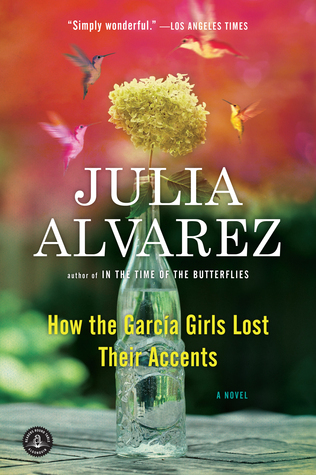How the Garcia Girls Lost Their Accents by Julia Alvarez
Summary (from the publisher): From the international bestselling author of In the Time of the Butterflies and Afterlife , How the Garcia Girls Lost Their Accents is "poignant...powerful... Beautifully captures the threshold experience of the new immigrant, where the past is not yet a memory." ( The New York Times Book Review )
"Alvarez helped blaze the trail for Latina authors to break into the literary mainstream, with novels like In the Time of the Butterflies and How the García Girls Lost Their Accents winning praise from critics and gracing best-seller lists across the Americas."—Francisco Cantú, The New York Times Book Review
"A clear-eyed look at the insecurity and yearning for a sense of belonging that are a part of the immigrant experience . . . Movingly told." — The Washington Post Book World
Acclaimed writer Julia Alvarez’s beloved first novel gives voice to four sisters as they grow up in two cultures. The García sisters—Carla, Sandra, Yolanda, and Sofía—and their family must flee their home in the Dominican Republic after their father’s role in an attempt to overthrow brutal dictator Rafael Trujillo is discovered. They arrive in New York City in 1960 to a life far removed from their existence in the Caribbean. In the wondrous but not always welcoming U.S.A., their parents try to hold on to their old ways as the girls try find new by straightening their hair and wearing American fashions, and by forgetting their Spanish. For them, it is at once liberating and excruciating to be caught between the old world and the new. Here they tell their stories about being at home—and not at home—in America.
Review: At a young age, the four Garcia sisters - Carla, Sandra, Yolanda, and Sofia - must flee their large, extended family and privileged lifestyle in the Dominican Republic and move to New York City. New York in the 1960s is an entirely different world than their life in the Caribbean and the sisters feel forever caught between the old world and the new. In this novel, told in reverse chronological order, the reader meets the adult sisters and works backwards to learn their stories and to see where they started.
This novel functions more like a collection of linked short stories. Each chapter is its own universe and could stand alone but each is from the perspective of a different sister. Quickly, it becomes evident that Yolanda is the central figure and is the most prominent perspective in the stories. It is unusual for a novel to work backwards chronologically but it actually worked quite well for this book. As the book progresses, layers are slowly peeled back so that slowly the reader uncovers how the characters became who they are and their origin is slowly revealed.
This book is beautifully written and apparently very autobiographical in nature. In the early chapters that feature the sisters in older ages, the clear sense of being split between two places and two cultures is felt. The sisters don't fully belong in either place and are stuck between their history and traditions and their new life in America. In the later chapters where the girls are still young, there is a keen sense of things being beyond their control and the helplessness of childhood. A beautiful meditation on sisters, family, tradition, family loyalty, and the effect of place on our lives.
Stars: 4



Comments
Post a Comment